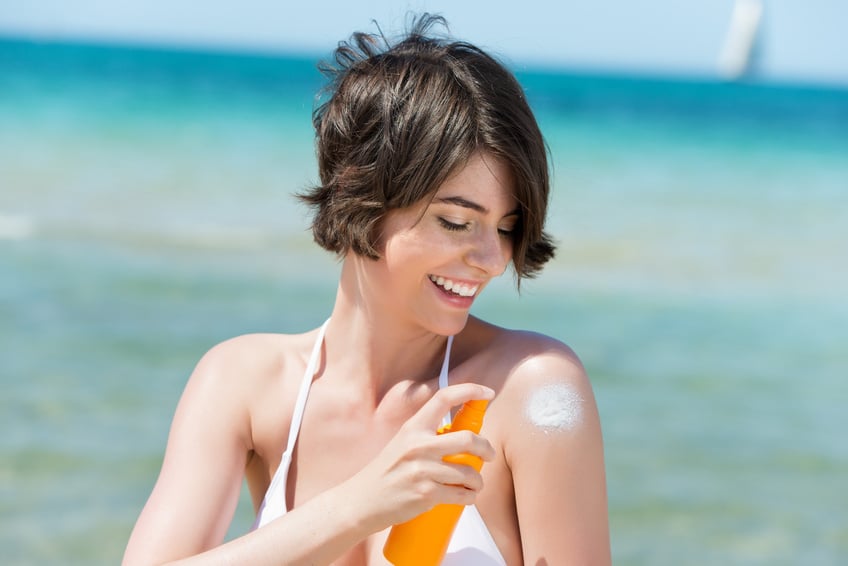ABC UV Protection
We enjoy the warm rays of the sun, however: Our skin never forgets a sunburn and is extremely unforgiving. Any excessive and unprotected sunbathing increases the risk of developing skin cancer. Fortunately, the cosmetics sector has developed enormously in recent years, so that today we have sun protection products available that effectively protect our skin from UV radiation. Our ABC UV protection clarifies all the important questions about the correct application of sunscreen and the use of sun protection products.
What should be considered at the seaside?
Every year, countless people are drawn to the sea. But the fact that UV radiation on the beach is much stronger than elsewhere is often forgotten. Two factors are responsible for the strong radiation: the bright, sometimes even snow-white sand and the reflection of the water. That is why the sun should be avoided during the midday period between 11:00 and 15:00. Especially children, whose epidermis is much thinner than the horny layer of the grown-ups, stay best in the shade, recommends our ABC UV protection.
And even splashing around in the sea can quickly lead to sunburn, because 85 percent of UV-A rays and 60 percent of UV-B rays penetrate below the surface of the water. Even half a meter under water, the radiation is as strong as if we were in the blazing sun. Waterproof sunscreen is therefore a must for ABC UV protection. However, these are not miracle cures either: their protective effect is gradually lost through bathing and drying off. Anyone who leaves the refreshing water should therefore reapply the cream. However, it should be noted that repeated creaming renews the protection, but it is not prolonged!
What is the best way to apply sunscreen?
It is always better to apply sunscreen before going to the pool or beach. The ABC UV protection knows two reasons for it. On the one hand, there is still enough time for the sunscreen to take full effect, and on the other hand, too little cream is usually applied directly on site so that there is no protective residue on the (swim) clothing. This can have fatal consequences, however, because sunburn is particularly common on the edges of bikinis and swim trunks. And even the swimwear itself usually does not offer reliable protection, which means that the skin should also be creamed under the clothing.
Another important aspect of ABC UV protection concerns the so-called sun terraces. This refers to those areas of the body that are directly hit by light, i.e. the forehead, nose, ears, shoulders, the backs of the feet, knees and décolleté. People who wear short hair or a ponytail are particularly susceptible to sunburn in these areas. Not without reason the sun terraces rank among the most frequent places, at which the light skin cancer appears, knows the ABC UV protection. They should therefore never be forgotten when applying sunscreen.
ABC UV protection: Correctly measured sunscreen
Two milligrams of sun cream or spray per square centimeter of skin is considered optimal according to the international standard. Converted per vacation week and person that would mean nearly 200 milliliters. The ABC UV protection calculates for an adult 30 milliliters for the whole body, that corresponds to an amount of approximately six teaspoons of cream.
But most people do not use enough sun protection, which means that the products cannot develop their effect sufficiently. Those who use cream should take a minimum amount for each body area, ranging from the wrist to the tip of the middle finger. Those who prefer sun spray should calculate about 15 sprays for each body area. Do not just spray on the spray, but distribute it well afterwards!
Extra tip in ABC UV protection: After each sunbath, the skin must be thoroughly cleaned of all sunscreen residues. Often the products leave an oily film, so that the skin cannot breathe freely.
ABC UV protection: Why a sunshade alone is never enough
Most parasols are not UV-proof, moreover, the sun’s rays can also gain access under the umbrella from the side. However, this does not mean that sunshades are useless, quite the opposite: a shady place is always better than a full-sun location. However, since about 40 percent of the radiation reaches the skin despite the umbrella, applying a good UV protection cream is indispensable. The same applies by the way with cloudy sky: Up to 90 per cent of the UV-rays can penetrate through the clouds! ABC UV protection therefore advises you never to forget to apply sunscreen, even under an umbrella or on a cloudy day!
Is special UV-protective clothing really useful?
On this subject, the views of experts differ. ABC UV protection says: In the water, for example when surfing, snorkeling or kiting, it is certainly a good addition to sunscreen. When buying, however, care should be taken to ensure that the UV-protective clothing is breathable and dries quickly.
ABC UV protection: The right clothes for sightseeing
For city or sightseeing tours, off-the-shoulder dresses and shirts are a poor choice. ABC UV protection recommends choosing tops that cover the shoulders and perhaps even have long sleeves. Alternatives are light shoulder scarves, which are simply folded over when needed, i.e. in the blazing sun, and can be stowed in the bag or backpack when not in use.
ABC UV protection for city trips, excursions and tours
Sun protection factor 50 is a “must” when traveling. This allows a person to be exposed to the sun 50 times longer than the natural protection of the skin. The actual time depends on the individual skin type. Humans with very bright skin, whose skin reddens already after five minutes, with SPF 50 achieve a protection for 250 minutes, which is sufficient for example for a half-day trip. Extra tip from ABC UV protection: The limit should always be exhausted only to a maximum of two thirds.
If you are unsure which protection factor is sufficient, you should look at the UV index of the weather app on your smartphone. From UV index 3, you should use a sunscreen if you want to be outside. By the way, it is important not to be stingy with the dosage, because if you apply the cream or spray too thinly, you risk lower UV protection. Under certain circumstances, SPF 50 then becomes SPF 25.
The current data is also published on the bfs.de site.
Nobody has to be afraid of unsightly residues or discolorations on clothing today. Current sunscreens do not leave stains and/or can be washed out well.
Make-up and sun protection in addition?
If you want to protect yourself optimally from the sun, you still don’t have to leave the house without makeup. The sunscreen should serve as basic protection and match your own skin type: Then the usual day cream can be applied. After that, make-up is no problem. The ABC UV protection advises: Foundation with sun protection factor is not sufficient, because the products offer usually only sun protection factor 20 to maximally 30. An additional UV-A protection is besides often not contained.
What to consider when vacationing in the mountains?
The higher a region lies, the more intense the solar radiation. The rule of thumb here is that the intensity increases by 20 percent for every 1000 meters of altitude. This applies not only when the sky is blue, but also when there are clouds or fog. Many travelers forget how quickly the altitude meters rise at some vacation spots: After all, many tourist destinations are already on a mountain. For example, those who spend their vacations in Davos (1600 meters) do not even have to “scramble” very high to soon be at 2000 meters. ABC UV protection therefore advises caution.
Anyone hiking in the mountains or mountain biking will also quickly work up a sweat, so the sunscreen should be waterproof. ABC UV protection also recommends starting as early as possible in the morning so that the most sun-intensive time between 11:00 and 15:00 can be spent, for example, during a rest in a hut or hotel.
How do I best protect myself from the sun on the mountain?
With a wide-brimmed headgear, sensitive areas such as the head, neck and ears can be well protected. But if you wear an open shirt, for example, you risk sunburn on your neck or chest, so it’s just as important to apply sunscreen carefully here as it is on your shins and calves when wearing shorts. Do not forget the forearms! ABC UV protection also advises using a high-quality lip balm with a UV filter, as the delicate skin on the lips is very sensitive.
ABC UV protection: The eyes also want to be protected!
Anyone traveling in the mountains should never do without sunglasses. The intense UV-A radiation can cause massive and lasting damage to the lens. But the conjunctiva also reacts to too much sun. If the eyes tear after the tour or are very red, the ophthalmologist administers drops containing cortisone.
It is also important not to wear “just any” pair of sunglasses. A recommended model offers reliable all-round protection against all incident rays, i.e. also against those rays that enter from the side.
ABC UV protection recommends: The fine skin of the eyelids also needs sun protection! Either by the shade of a wide-brimmed hat or with good quality sunglasses!
How to recognize high-quality sun protection products?
This is indeed not always easy, and consumers are often blinded by the prices of discounters. They may contain raw materials that are no longer up to date. If you want to use good sunscreen products, make sure the product is octocrylene-free. Octocrylene is a very inexpensive UV filter, but it is suspected of having hormonal effects and is ecologically very questionable. Octocrylene is also suspected of accelerating the death of reefs.
Also, the two UV filters ethylhexyl methoxycinnamate and butyl methoxydibenzoylmethane should no longer be combined in a modern UV protection product. Both UV filters degrade when exposed to UV light (are photo-instable) and thus release degradation products that are toxicologically questionable. The two UV filters homosalates and ethylhexyl salicylates are only weakly effective and are also suspected of having hormonal effects.
Avoid using waterproof sunscreen products. These sun protection products contain polymeric film formers, which are now to be evaluated as microplastics. These raw materials can be recognized by the INCI designations -acrylates, VP/Hexadecene Copolymer, VP/Eicosene Copolymer, C8-22 Alkyl Acrylates/Methacrylic Acid Crosspolymer, Styrene/Acrylates Copolymer, Polyester-7, Polyamides, Acrylates/C12-22 Alkyl Methacrylate Copolymer and Acrylates/Vinyl Neodecanoate Crosspolymer.
However, it is not only a matter of avoiding microplastics, but we must get used to simply reapplying cream after spending time in the water. This is the only way to ensure optimal protection.
For more information or samples regarding octocrylene-free and modern sunscreen products, contact us.
ABC UV protection: high quality sun protection thanks to the expertise of Cosmacon
Sun protection is important not only in cosmetic terms, because our skin unfortunately does not forgive mistakes. Too much sun exposure causes premature aging and in the worst case can lead to skin cancer. At Cosmacon, we develop high-quality sun protection for you according to your wishes. So that we can all continue to enjoy the sun (in moderation).
Sources:
Sunscreens and Photoaging: A Review of Current Literature.; Am J Clin Dermatol. 2021 Nov;22(6):819-828.
Environmental Impact of UV Filters.; Actas Dermosifiliogr. 2022 Sep;113(8):792-803.
Insights into the structure of sunscreen lotions: a small-angle neutron scattering study.; RSC Adv. 2021 Apr 16;11(24):14306-14313
Epidemiology of Melanoma.; Med Sci (Basel). 2021 Oct 20;9(4):63.

